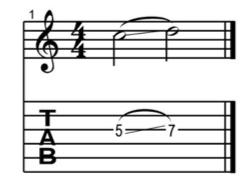How to Play “Legato Slide”
Legato is a technique which enables you to play notes without using your picking hand, by purely playing using your fingers on your fretting hand.
Because you only need to be focused on one hand, you don't need to be worry about two hand synchronisation and therefore legato enables you to achieve faster speeds in your guitar playing much more easily. And also a smoother sound - hence the word legato.
One way of playing legato is what is called the “legato slide”. A legato slide is being played by hitting the “starting pitch” with your pick and then you slide - with the same finger you have fretted the starting note – across the guitar neck to the target note.
Ex. 1:
In the first example you are seeing an upwards slide, starting from the 5th fret of the G string and ending on the 7th fret on the same string.
I've laid out 4 steps for you witch you should follow, in order to master the legato slide:
1.) Let the starting note ring out cleanly and hit the string hard enough, so that the note is sustaining long enough and doesn't get lost by applying the slide.
2.) Focus your eyes already on the target note before you play the slide. This will make it much more easy for you to hit the right string.
3.) Play the slide in a speed which will help you hit the target note cleanly, so that it still rings after you hit the target note with the slide.
4.) Practice the slide with all 4 fingers, one after the other.
Variations:
There are several variations on how you can play the legato slide, here are the most important ones:
Ex. 2:
The second example shows you a downwards slide. You play it by hitting the starting note, like you did with the upwards slide, but this time you are sliding downwards to the target note instead.
Ex. 3:
Example 3 shows you an upwards-downwards slide. It is played in the beginning like the upwards slide, by hitting the starting note with your pick and sliding up to the first target note. After hitting the first target note you are then sliding down again - without hitting the string again with your pick - to the second target note (witch is the starting note in this example).
Ex. 4:
Example 4 shows you a downwards-upwards slide. It is played in the beginning with the downwards slide, by hitting the starting note with your pick and sliding down to the first target note. After hitting the first target note you are sliding up again - without hitting the string again with your pick - to the second target note (witch is the starting note in this example).
Now that you've learned how to play legato slides and their variations, you may want to use them creatively in your playing. Just try to implement this technique into the music you are already playing, to make it sound more interesting!
This article was written by Marco von Baumbach, guitar teacher in Wuppertal, Germany.




